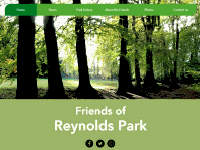|
(Continued from previous page)
Several of the present-day features of Reynolds Park are the result of alterations commissioned from Professor Charles Reilly by James and his wife Leila, who Reilly, in his autobiography, called "the lady in white". These included a lily pond (now gone), clipped yew hedges (still there) and an "outdoor dining place" (closer to the sundial) where she entertained some of Liverpool's leading literary figures. Other amenities - all now gone, but in some cases visible as brick outlines in the ground - included a swimming pool (above the ha-ha steps down to the wildflower meadow) and a summer house. 'The Dell' - a landscaped former quarry, still visible over the wall alongside the Woolton Hill Road driveway - was once accessed by a tunnel and a zig-zag path from the main grounds.
Before the Reynolds family - with their 12 children - took over, Dove Park was the home of George Cope, a tobacco manufacturer ('of Liverpool and London') who had bought it at auction in 1873 and whose widow sold it in 1907. It was the Cope family who had enlarged the original estate (and its house, on the site of the present-day sheltered housing complex, Calvert Court, Church Road) by acquiring an adjacent property which had its entrance in Woolton Hill Road. This next-door house, which was demolished around 1886, had been the home of John Dennison (d.1865), a retired Liverpool ironmonger who was also a 'conchologist' (his collection of shells was acquired by Liverpool Museum). Woolton Park was called Dennison Road in the 1861 Census, so presumably he had been involved in its creation.
The Walled Garden - one of Reynolds Park's finest features today - was the responsibility of an even earlier owner, John Crosthwaite. It was he who, in 1828, had bought 8½ acres of land from 'Richard Weston & others', the assignees of John Weston, a Liverpool merchant who had acquired land under the Childwall, Great and Little Woolton Inclosure Act of 1805 but by 1813 was bankrupt.
John Crosthwaite (c.1793-1866) was a West India Merchant, a Trustee of the Blue Coat school, and a director of the Demerara Railway (Guyana) - a man who had undoubtedly profited greatly from the slave trade and slavery. Bennison's Map of Liverpool shows that by 1835 he had built a substantial house, walled garden and outbuildings. The Much Woolton Tithe Map of 1840 shows that, by that time, the walled garden was almost complete, and the ha-ha or sunk fence at the boundary of the 'pleasure grounds' was in place.
Reynolds Park is a much-appreciated local asset. The Friends of Reynolds Park help with maintenance and litter-picking, and have produced a Heritage Trail leaflet containing a map of its main features.
|
|



